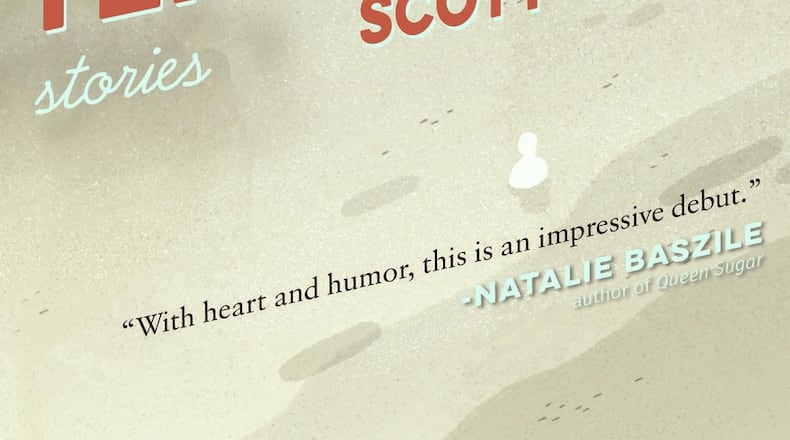“I’ve never figured out what it was about being 13,” says the unnamed narrator in Scott Gould’s animated debut, “Strangers to Temptation: Stories,” “the way you think you’re the core of every existing universe, the way any event that happens to you is epic and mythic, the most important thing that will ever occur.”
It’s a keen observation, even if it does low-ball the experiences of his fraught and fractured adolescence. In 1970s South Carolina Lowcountry, small, seemingly innocent acts snowball into catastrophic ones, and the dangers lying beneath the cola-colored Black River succeed in luring teenage boys standing at the edge of Baker’s Bridge to disastrous fates. Our witty hero, the common denominator in each of these 13 linked stories, seems unfazed by such risks, and his increasing independence imbues him with a sense of invincibility. “When you’re 13, tragedy is a passing annoyance,” he says.
In “The Orbit,” the narrator finds himself envious of his friend Lonnie Tisdale, who uses his artificial eyeball to steal away the narrator’s crush. The story poignantly captures the frustration of adolescence, along with the disappointing realization that even the briefest of hesitations, the smallest of missteps, can produce undesirable long-term consequences. “Live long enough. You’ll look back and regret your collection of tiny moments when you turned left and should have gone right, when events — cosmic or otherwise — conspired for or against you.”
While his mother is working double shifts as a nurse to support the family, the narrator’s father in “The AC” hides out in an air-conditioned 1972 Lincoln with the neighborhood widow to discuss communism and the Vietnam war that left him permanently disabled. It’s a dazzling take on marital discord, the not-so-innocent flirtations between adults, and the fuzzy line between decency and impropriety. In his father, the narrator sees a fallible adult and a glimpse into his own possible future. “I realized then I was destined to spend a lot more time in my life looking to be forgiven than doing the right things, which wasn’t so much a depressing thought as it was exhausting.”
In “Stand-In Jesus,” one of the strongest stories, Gould delves deeper into the psyche of the narrator’s father, whose beard and emaciated frame deem him the perfect actor to play the persecuted Son of God in the church’s annual Easter production. The story is a searing comment on trauma and the inadequacy of so-called redemption, and Gould’s prose here is precise and invigorating. “What we remember and what we choose to forget is never up to us. If it was, we’d recall only the happiest moments of our lives, or perhaps those times when we realized beyond a shadow of a doubt that we were about to change forever, that nothing would ever be the same again.”
Where Gould stumbles, is when he addresses race. “Bases” describes a laughing, barefoot, “big and sweating,” seemingly nonverbal black boy (he speaks only in our narrator’s dream), who, during a baseball game that takes place on the white side of the railroad tracks, pelts a rock at a white player’s face.
White locals demonize him and the other residents of Nicholtown (which they call N-town). White children fantasize about conjuring Hitler’s ghost to exact revenge, and even our narrator describes the rock-thrower as unsightly. “He wore a pair of blue jean shorts split way up his legs and no shirt. It looked like he had rubbed some of the new lime on his chest. I could see two white hand prints smeared across his belly.” This cold assessment seems contrary to the narrator’s typically ruminative nature, and the use of a two-dimensional black character as nothing more than a target for white characters’ racial slurs reads like an unfortunate trope.
The same can be said of “May McIntosh Flies, John Wayne Runs,” which introduces white flight and school desegregation with little probing. The narrator asks his black friend Columbus to attend a football game with him at the new private school where the wealthy white students enroll after desegregation. When Columbus reminds the narrator it’s “not a good idea,” the story opens the door to the narrator’s reflection on race-related aggressions. Instead, the narrator casually chalks up Columbus’ response to maturity and self-preservation, completely side-stepping his friend’s very real, underlying fear.
The racism in these two stories feels like an inconsequential setting, one that more appropriately belongs in a collection with an oblivious or self-absorbed narrator. But our guide in “Strangers,” is perceptive and discerning. He condemns the depravity of adults and challenges the status quo. This lack of a deeper engagement with the racial forces that shape small-town South Carolina in the 1970s seems like a missed opportunity.
Despite this shortcoming, Gould has produced a compulsive read. His prose shines, and by linking these stories, as opposed to compiling them in novel form, he highlights the very essence of coming of age, how the myriad, sporadic events in a young life, serve as vital stepping stones on the daunting and oftentimes imperfect journey to adulthood. “One day a switch will flip on and you’ll get about half of life figured out,” our narrator muses. “The other half will stay a mystery. Half is about the best you can hope for.”
FICTION
‘Strangers to Temptation: Stories’
by Scott Gould
Hub City Press
216 pages, $16.95
About the Author
Keep Reading
The Latest
Featured

